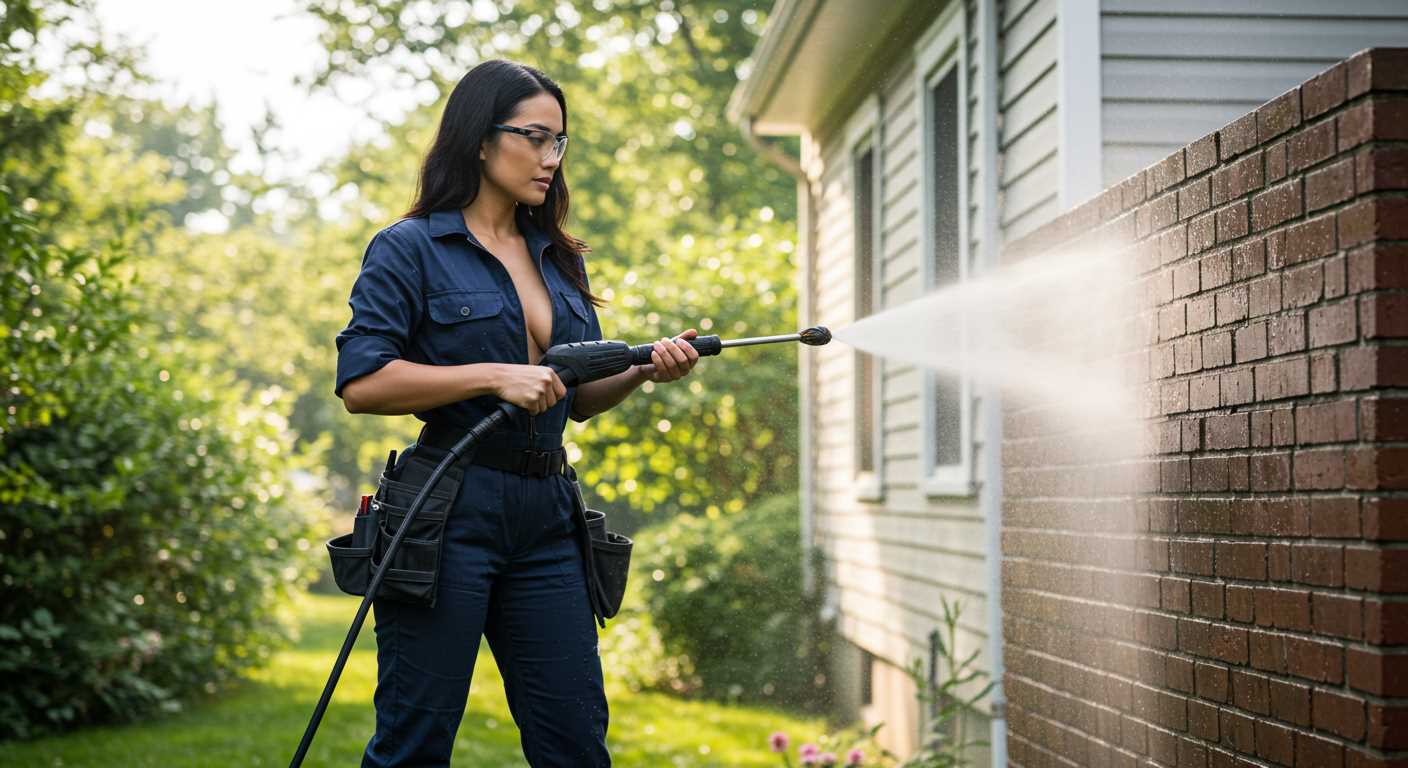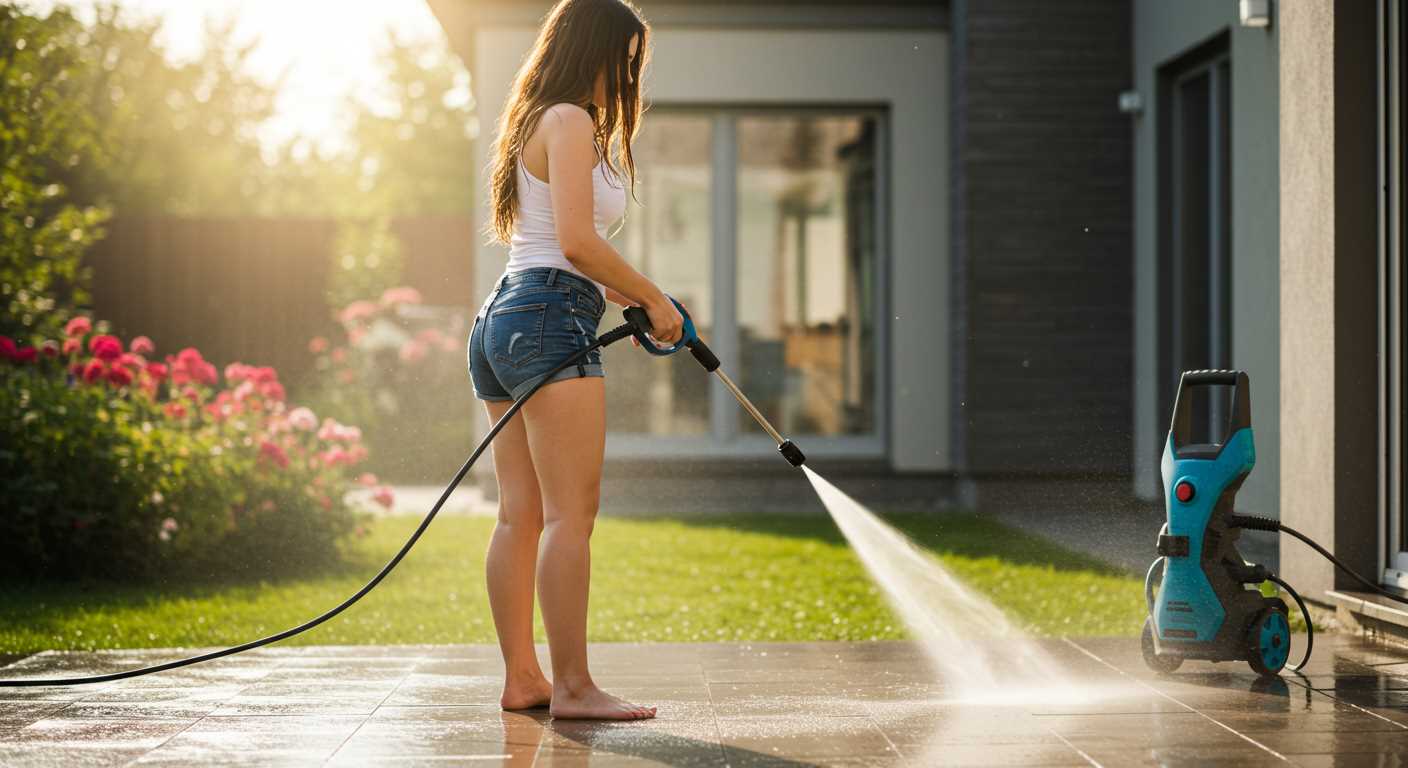



For effectively removing dirt and grime from exterior surfaces, I recommend using a machine that generates between 1400 and 2000 psi. This range strikes the ideal balance, ensuring thorough cleaning without risking damage to your property. For typical household materials such as wood, brick, and concrete, this pressure is sufficient to tackle tough stains while being gentle enough to avoid etching or stripping away paint.
When selecting a cleaning device, it’s also crucial to consider the flow rate, measured in gallons per minute (GPM). A minimum of 1.3 GPM will enhance your efficiency, allowing for faster results while using the same amount of pressure. This combined metric of psi and GPM plays a significant role in achieving optimal outcomes–providing a powerful yet manageable performance.
Prior to beginning your cleaning session, ensure you choose the correct nozzle. A 25-degree nozzle provides the versatility needed for various tasks, from washing sidings to patios. For stubborn spots, a narrower nozzle can be applied selectively, ensuring concentrated cleaning where required. Ultimately, matching the apparatus specifications to the types of surfaces and dirt levels will yield the best results.
Identifying the Right PSI for Porous Surfaces

For porous surfaces like brick, concrete, or certain types of wood, a range of 1500 to 3000 units is advisable. This level allows thorough removal of dirt and grime without damaging the material. Starting at the lower end for softer or more fragile surfaces is prudent.
Test first in an inconspicuous area. A distance of around 12 to 16 inches from the surface helps prevent etching or pitting while ensuring effective cleaning. Adjust your approach based on the results, gradually increasing the pressure if needed.
For vertical surfaces, maintaining a consistent distance is crucial. Operating at a steady angle helps remove contaminants effectively, especially in textured areas where dirt can accumulate. Using the right nozzle–typically a 25-degree or 40-degree–provides an optimal spray pattern for achieving balance between power and gentleness.
In the case of weathered wood, keep pressure below 2000 units to avoid splintering. Using a wide-angle nozzle will aid in even distribution and reduce the risk of damage. Remember, less pressure can sometimes lead to better results.
Regular maintenance and cleaning can prolong the lifespan of porous materials, making appropriate pressure settings and techniques even more significant. Always consider the condition of the surface and adjust accordingly for the best outcome.
Recommended PSI for Exterior Walls and Sidings

A range between 1300 and 2500 PSI is most suitable for cleaning exterior walls and sidings effectively. Surfaces such as vinyl and aluminium can typically handle pressures at the lower end, while more robust materials, like wood or concrete, may require increased force for thorough removal of dirt and grime.
Specific Recommendations
.jpg)
For vinyl siding, maintain a setting around 1300 to 1600. This pressure will avoid damage while still providing adequate cleaning. If the walls are aluminium, you can use a force slightly higher, around 1500 to 1800. Wooden sidings need careful consideration; aim for approximately 1600 to 2000 PSI to prevent gouging or splitting the wood.
Factors to Consider
Always distance the nozzle approximately 2 to 3 feet from the surface to prevent any unintended damage. Test a small, inconspicuous area before proceeding with larger sections. Adjustments may be necessary depending on the specific environmental conditions and the level of accumulated debris. If mildew or tough stains are present, increasing the pressure within the recommended range should be effective.
Appropriate Pressure Settings for Driveways and Patios
For driveways and patios, a setting between 2000 and 3000 units is generally optimal. This range effectively removes dirt, grime, and stains without damaging the surface. Concrete and brick surfaces can handle higher intensity, while composite materials may require gentler treatment.
Considerations for Specific Surfaces
When tackling concrete driveways, adjust the tool to around 3000 units. This level efficiently lifts embedded stains from oil, grease, and tyre marks. For patio areas made of tiles or pavers, a setting of 2000 to 2500 units suffices. Ensure to maintain the nozzle at least 12 inches away from the surface to prevent any chipping or surface damage.
Additional Tips for Effective Use
Testing a small, inconspicuous area before proceeding is advisable. If you notice any damage or excessive wear, decrease the intensity. Employing a fan tip nozzle can assist in evenly distributing the stream across larger areas, enhancing the overall cleaning experience. Regular maintenance of your equipment prolongs its life and improves its performance.
Choosing PSI for Windows and Outdoor Furniture
For windows, I recommend using a range of 1300 to 1600 psi. This setting is ideal for removing dirt and grime without risking damage to the glass or sealing. Always maintain a distance of at least 12 inches from the surface while applying water and use a wide fan nozzle to diffuse the impact.
When it comes to outdoor furniture, the appropriate range is between 1200 and 1500 psi, especially for plastic and metal finishes. It cleans effectively while ensuring that no scratches or dents occur. For wooden furniture, lower the setting to around 1000 to 1200 psi to protect the surface and the finish.
| Surface Type | Recommended Pressure (psi) |
|---|---|
| Windows | 1300 – 1600 |
| Plastic Outdoor Furniture | 1200 – 1500 |
| Metal Outdoor Furniture | 1200 – 1500 |
| Wooden Furniture | 1000 – 1200 |
Always remember to start with a lower setting if unsure, gradually increasing the pressure as needed while observing for any signs of damage. Using the correct pressure ensures safety and longevity of your fixtures.
Understanding Different Nozzle Types and Their PSI Ratings
For effective outdoor tasks, the choice of nozzle significantly impacts both the cleaning performance and the required water force. Nozzles are colour-coded, indicating their spray angle and intensity, which determines the appropriate application method. Each type suits various surfaces and cleaning requirements.
The red nozzle (0-degree) delivers a concentrated, narrow jet, ideal for tough stains on hard surfaces but can easily damage items like wood and metal. A yellow nozzle (15-degree) offers more versatility, effectively tackling grime on concrete and brick without causing harm. On the other hand, the green nozzle (25-degree) is a great option for larger areas, providing coverage while being gentle enough for surfaces like vinyl siding.
The white nozzle (40-degree) creates a wide fan spray, perfect for delicate tasks such as cleaning cars or outdoor furniture. Lastly, the soap nozzle is typically marked with a black tip, designed specifically for applying cleaning solutions effectively prior to the rinse cycle.
Understanding the relationship between nozzle type and pressure level helps in selecting the right combination for various jobs, ensuring optimal results without damaging the surfaces involved.
Comparing Electric and Gas Pressure Washers: PSI Considerations
For residential use, selecting between electric and gas models often hinges on their power ratings. Electric versions typically range from 1300 to 2100 psi, making them suitable for light to moderate tasks, like washing cars or cleaning outdoor furniture. In contrast, gas-powered units boast higher performance, usually exceeding 2500 psi, giving them the edge for tougher jobs such as removing stains from driveways or cleaning larger exterior surfaces.
Performance Levels
Understanding the differences in performance helps clarify which type meets your needs:
- Electric Models: Convenient for light-duty tasks, ideal for residential cleaning. They are quieter and do not require fuel. However, their limitations may become apparent when dealing with heavy grime.
- Gas Models: More powerful, capable of handling challenging cleaning jobs. Though louder and requiring more maintenance, they excel in removing stubborn dirt from hard surfaces and are ideal for extensive areas.
Recommendations Based on Tasks
The following guidelines can help you decide which option suits your specific needs:
- Light Cleaning: Opt for electric units for tasks like washing garden furniture or small decking areas. 1300-1700 psi is generally effective.
- Medium Cleaning: For siding or wooden decks, consider electric options in the 2000 psi range or gas models around 2500 psi for more pressure.
- Heavy Cleaning: Require stubborn dirt removal? Gas models with capabilities above 3000 psi are recommended for heavy-duty tasks.
Overall, the decision ultimately rests on the intensity of the tasks you aim to accomplish. Assess the types of surfaces you’ll be working with and select accordingly for the best results.
Maintaining Your Pressure Washer for Optimal PSI Performance
To ensure peak functionality of your cleaning tool, regular maintenance is critical. Here are key actions I recommend:
- Regularly inspect hoses and connections: Check for leaks, cracks, or bulges. Replace any damaged components immediately to avoid pressure loss.
- Clean filters: Dirt and debris can significantly hinder performance. Rinse filters periodically and replace them as needed, especially after heavy use.
- Examine the intake water supply: Ensure that water is flowing freely. Any blockages can lead to inadequate results.
- Check oil levels: For gas models, maintaining proper oil levels is essential for optimal engine performance. Change the oil according to the manufacturer’s guidelines.
- Test the nozzle: A clogged or worn nozzle can affect pressure. Clean or replace nozzles regularly, based on usage.
- Store properly: After each use, store the unit in a dry, sheltered area to prevent rust and damage. Using a cover can provide extra protection from elements.
By implementing these maintenance tips, you can sustain the operational efficiency of your equipment, enhancing its cleaning capabilities while prolonging its lifespan. Regularly caring for your device ultimately leads to consistent and satisfying results.








